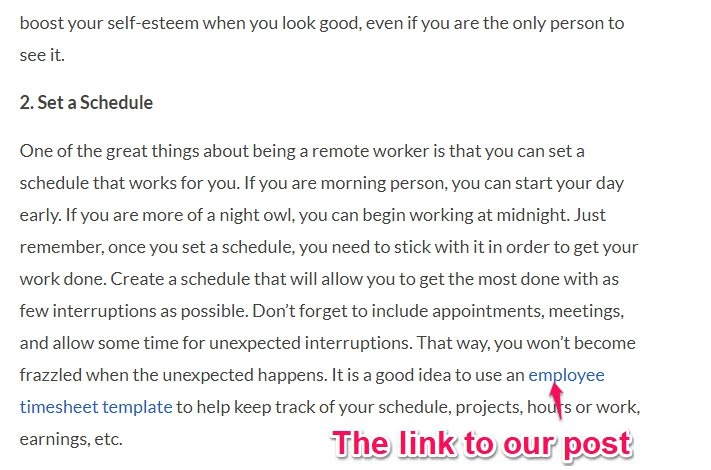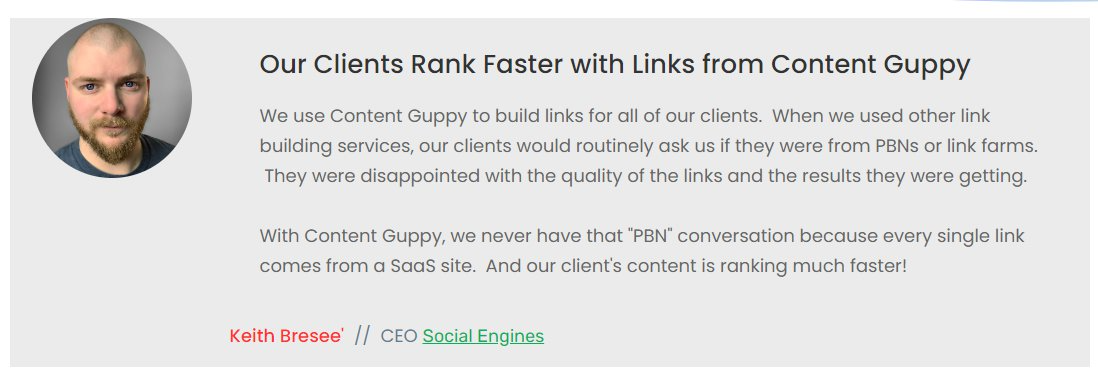White hat link building is a strategy of link building that strictly adheres to the rules and regulations that Google has set forth.
And when done correctly, can have a powerful impact on your company’s MRR.
For instance, in just a few short months, we took this landing page

from position 9 (and earning 2-3 leads per month) to position 1 for its keyword and now generating 16 leads per month.

More than quadrupling the revenue the company generates from just this one page.
Black Hat Link Building Vs White Hat Link Building
Black hat link building is the “shady” link building practice that used to work “back in the day” but no longer works.
In fact, your site can be penalized for practicing black hat link building.
These are links that come from PBNs, link farms, are auto-generated in comment sections, and from sites with high spam scores (meaning the site has high outgoing link to incoming link ratio).
Most reputable link building agencies, including Content Guppy, avoid black hat link building at all costs.
Meanwhile, white hat link building is getting a link that you “earn” on a reputable business - either because the quality of your content is that good, OR, you have contributed to the company’s site in some way.
White hat link building is the safest way to stay within Google's guidelines.
A Word of Caution
When you hire a link building service or build your links in-house, always make sure to apply several filters in order to weed out PBNs and link farms from your outreach. By using online background checking tools, you can verify the legitimacy and reputation of your link-building partners.
At Content Guppy, we ensure that we practice white hat link building because we’ll only do outreach to SaaS companies and Agency/service companies. This ensures we ONLY do white hat link building and will never put your site or your business in jeopardy.
PBNs and link farms are getting so good at disguising themselves that we don’t even take a chance reaching out to content sites anymore. Better to be safe than sorry.
5 Proven White Hat Link Building Strategies that Deliver Results
Now that you know what white hat link building is and the powerful benefits, let’s talk about some strategies you can deploy to grow your rankings.
Guest Posting
Back in the day, guest posting was an amazing way to generate tons of traffic. You could build an entire business off of guest posting alone.
That’s not necessarily the case these days. But that doesn’t mean incorporating guest posting into your blog promotion is a bad idea.
Guest posting is one of our favorite ways to build links, especially from high domain sites.
It’s how we were able to get a link on Glassdoor.com (DA 90).

Step 1: Find a blog to write your post
So, the easiest way to find a blog to write for is to use Google.
You can simply enter the terms:
- “Name of niche” and “guest blogger”
- “Name of niche” and “write for us”
- “Name of niche” and “guest writer”
And you’ll wind up with dozens, if not hundreds, of blogs who are accepting guest posts.
For instance, if I type in “Marketing” and “write for us”, I get pages and pages of blogs looking for guest posts:
Step 2: Analyze the Domain Authority
Let’s face it. Guest posting can take quite a bit of time. And you don’t want to waste that time on sites that don’t have a high domain authority after you check domain authority score.
Typically, I only write guest posts for sites with a domain authority greater than 60.

Step 3: Pitch the editor
Now that I’ve found a blog to write for, it’s time to pitch the editor.
The first thing I do is look for blog posts that have been successful and come up with an idea around how to spin a new angle.
For instance, if I notice a blog post called “10 ways to nurture leads” gets a lot of shares and comments, then I might do something like “A Case Study on How I Nurture Leads”.
(Totally made up and a bad example, perhaps, but you get the point. I’d write my article around lead nurturing.)
Finally, I'd do a reverse email lookup to ensure that I'm emailing the correct person; sending emails to people other than the editor is a waste of time and might actually cost you a guest posting opportunity.
Then, I’d pitch them using this script.

And it works almost all of the time!

Step 4: Write a killer post
Now it’s time to write a killer guest post. It has to be really good! You want to endear yourself to both the readers of the new blog AND the editor of the blog.
You may not get tons of traffic from your guest post, however, if you do good work for them, they will be much more inclined to share a future post or partner with you down the road.
Pro Tip: When you’re looking for blogs to write your guest post, make sure you’re allowed to include a link to your site in the body of your article and not just the author bio. Links in the content are worth more than links in the bio.

And just link that, you have a powerful link that search engines will absolutely love.
Guest on Podcast
Let’s face it. Guest posting at scale can take a LONG time.
Writing blog posts can take hours to write. Then you submit it for a few rounds of edits. Before you know it, you’ll have spent 7-10 hours writing one guest post.
Enter another of our favorite white hat link building techniques, guest podcasting.
Many people don't think of guest podcasting as a way to get high quality backlinks, but we've gotten some amazing links by going on other people's podcasts.
It takes 15 minutes to write your pitch. An hour (at most) to be on the podcast. At the end of the podcast, the interviewer will usually ask what you want to promote. You can give them the landing page/service page of the product that you’re looking to rank.
And you got your link. (Not to mention you’ve been in the ear of your target audience for almost an hour. That’s got to be worth something too, right?)
So here’s how to do it:
Step 1: Find a Podcast to Appear On
You can do this a couple of ways.
The first way is by using Google.
Look what happens when I search for “best marketing podcasts”.

I get a ton of “list posts” about marketing podcasts.
Then I can click on each of these lists to see which podcasts work for my business.
The second way to do this is by going through the podcasts that you already listen to.
If you’re listening to these podcasts, then maybe your customers are as well.
Step 2: Identify Gaps
Once you’ve found the podcast that you’re going to pitch, you need to identify the content gaps that you can fill. It’s a bit like demand forecasting, you have to analyze several points of data to make informed predictions of content gaps.
With a podcast, you don’t want to pitch the EXACT SAME THING as someone else. The topic has already been covered.
You need to pitch something that is a bit different - an angle that will appeal to the host and the readers.
For instance, I was pitching the “Everything is Marketing” podcast. And they had a few episodes on SEO.
So I knew SEO would be a good topic. But I needed to find a bit of an edge.
I pitched the podcast on an SEO strategy that would take just 30 minutes per day.
Step 3: The Pitch
Now you need to send your email.
Here’s the email I sent to the “Everything is Marketing” podcast.
Hey Corey
I was listening to your podcast episode with Benji Hyam where you guys were talking about creating a bottom of funnel content using Alternative Posts.
LIke you said, they convert like gangbusters! This is such a great strategy that I’ve seen make a significant impact for other companies. Thank you for sharing this valuable tactic that more people should be utilizing to get ranked for their competitor’s alternatives.
Because you do such a great job of teaching your audience how to grow their business through practical marketing strategies, I thought they would also love to know how to create a huge boost in visitors through an seo strategy that just takes up just 30 minutes each day.
I’ve also found a really cool keyword strategy that helps me create content “easily” which I could share too!
Are you interested?
Thanks,
Greg
So not only is guest podcasting a great white hat link building strategy, but you get to be in the ear of your ideal customer for an hour selling your products and services. Also, consider complementing your outreach efforts with a comprehensive guide to phone systems, offering valuable insights into communication for enhanced business connectivity.
Contextual Link Building
Contextual link building is the act of reaching out to other websites in hopes that they will add a link within the context of their already existing content.
This is the exact process we use most often to acquire some of the best links for our clients.
Back in the day, this was a fairly common practice for getting a link - and not all that difficult. Times have changed.
In order to get a contextual backlink, you need to create something insanely compelling. After the links are earned, backlink management tools can be used to track the performance of those links.
Here’s how it works.
Step 1: Find Relevant Articles
First, we have to find a list of sites who might want to include our link in their article.
To do that, we use Ahrefs Content Explorer.

Then we apply all of our filters.
These are:
- One page per domain
- Exclude Home Page
- Site Traffic 1000
- Domain Rating from 60-90

Then we export the list.
Step 2: Find Person Closest to the Content
Now we have to find the person to reach out to.
We use LinkedIn to do this.
And that’s because we want to get the person closest to the content. We don’t want to send our pitch to the CEO or Founder or CMO if we don’t have to.
Instead, we want to send our pitch to the SEO manager or the content marketing specialist.
So you can search the companies, and then go to the “people” tab.

And then you want to find people with “Content” or “SEO” in their job title.

Step 3: Send a Pitch
Now, it’s time to send your pitch.
Three things:
Make it personal. Use their first name at all times.
Show that you’ve ACTUALLY read the content. This is important. (Actually read the content!)
Ask for the link.
Here’s an email that worked for me.
Subject: Quick Question
Hey Victor
I was reading your article on the 6 ways your B2B Business Can Establish Trust with Your Prospects.
You mention creating content marketing assets as one of the ways to create trust. Far too often, brands think they can just buy some ads on Facebook or Google or whatever, and see success.
But I can't tell you how many times a customer has said to us "we've been reading your blog for 2 years."
The other idea that you had which is really good is making it easy to contact the brand. If I can't find a way to get in touch with someone, then I'm not buying.
We wrote a post called "how to set up a call center" that can help companies make it easy for their customers and prospects to reach out to them. It will fit perfectly in your article.
Let me know if you’re interested.
Greg
And if you follow this process, you're going to wind up with some high quality backlinks, just like we provide to our clients.
Write a Testimonial/Case Study
This is such an underrated way to get a white hat link.
Let's face it, long form content can be a drag to create. But with a testimonial, you don't have to worry about that.
All you have to do is agree to write a case study or give a testimonial to the tools and services that you use.
For instance, my buddy Keith has been using us to get links for his clients for while now. He recently launched a brand new site and wanted a link to it.
So, he gave me a testimonial in exchange for the link.

Make a list of all of the tools/products/services that you use in your business.
Send an email to the head of marketing, head of content, or founder (depending on the size of the company) to each of those companies and offer to write a testimonial or an in depth case study.
And then ask if they’d be willing to link back to you.
This is a win-win at the highest level. Not only will you get a white hat link, but the other site will get some much needed social proof.
Integration Partner
Being a SaaS company, one of the white hat link building strategies that Time Doctor does is build integrations with other tools.
This allows us to leverage partnerships with those other companies to drive relevant traffic to our site.
For instance, one of the tools we work with is called WorkflowMax and we are listed on their integration page.

In the past 6 months, that integration page has sent over 265 people in the form of referral traffic to Time Doctor.

This is just one partnership. Multiply that by 10 or 20 and traffic starts to add up
Final Words
White hat link building is a pillar in search engine optimization and a powerful way to rank your content and key pages.
If you’re looking to acquire high quality white hat links using the strategies above, then contact us and start ranking your content.




About The Author: Greg Digneo
I love helping people with their marketing. So I created this site to give you tools and information to help you grow your blog, build your audience, and get more sales.
More posts by Greg Digneo